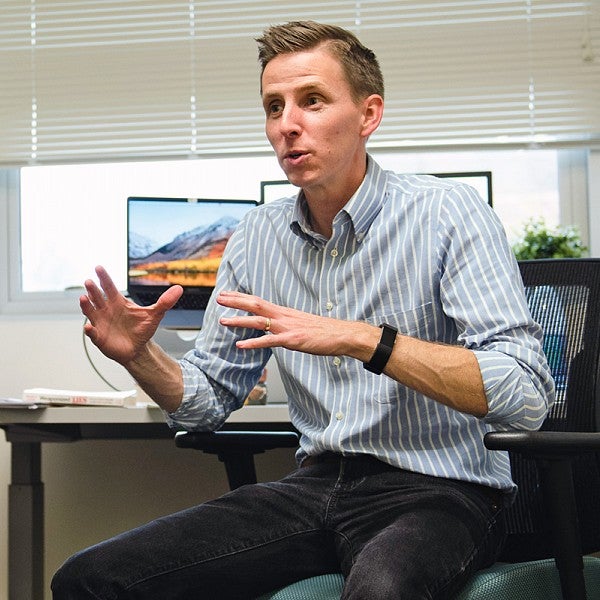
Although not everyone agrees what constitutes “fake news,” research shows that misinformation and disinformation are a growing feature of our current media environment.
As people retreated indoors to physically distance and attempt to cope with the health, economic, political and racial inequality crises that defined 2020, many turned to their social media feeds to make sense of the world outside.
“People are looking for a story and message that can provide a ready solution,” said Seth Lewis, Shirley Papé Chair in Emerging Media and professor in the School of Journalism and Communication. “It is in these situations that misinformation, disinformation and conspiracy theories thrive.”
Lewis notes that not all false information is created equally. He defines misinformation as “unintentional or seemingly accidental forms of bad information sharing,” compared with disinformation, which is a “more purposeful, deliberate attempt to mislead people.”
Both misinformation and disinformation have become key challenges for social media platforms, particularly amid the rise of QAnon and anti-vaxxer conspiracy theories. By some measures, the spread of “false content producers” is worse on Facebook now than it was in 2016.
What has changed since then, however, is greater awareness of the “fake news” phenomenon. Today, people more readily know false information exists and how to look out for it in their social media feeds and Google searches. But there is still a learning curve, Lewis notes. In addition, he said, the profusion of misinformation has, for many people, contributed to an overall weakening of trust in news media.
Lewis has researched digital journalism and its modalities for over a decade. During the 2019-20 academic year, he was a visiting fellow with the Reuters Institute for the Study of Journalism at the University of Oxford, where he studied how people identity with news in their everyday lives and how emotions and partisanship inform people’s understanding of media bias. He found that people often feel they are on their own to verify information, but they may overestimate their abilities to find out what’s true online.
“In many cases, people are not well equipped to engage in fact-checking,” he said. “They may even think they can check facts better than journalists because they often have such little trust in journalists.”
In October and November, Lewis co-hosted the “Journalism, Politics and the 2020 Election” Zoom webinar series with associate professor of journalism Nicole Dahmen. During the five-episode series, they convened UO faculty and alumni experts to discuss journalism’s role in covering politics — particularly during this year’s divisive election.
“It shouldn’t be about partisanship,” Lewis said. “We should be moving toward developing a mode of doing journalism that is much more aggressive in seeking the truth and making that truth much more apparent to its audience.”
When there is so much information to consume about the election, the economy and the pandemic, it is essential to understand what is professionally vetted journalism and how to differentiate fact from fiction, Lewis said.
“My suggestion: After you read something that really pushes your buttons and makes you want to share, take a moment to pause,” he said. “Give it an extra degree of thought before you share, to consider the reputation of the source and the work that went into producing that information — because all of us can have a part to play in slowing the spread of misinformation.”
The 2020 election also highlighted many of the ways disinformation and misinformation threaten contemporary journalism by muddying the waters between truth and falsehoods. Lewis said that low public trust in the media, coupled with the unprecedented speed and scale of information distribution, provided a perfect storm for the spread of false stories that appealed to people’s strongly held political identities.
Lewis thinks this could be a positive inflection point, however. He referenced what journalist Jay Rosen wrote about journalism’s future soon after the 2020 election.
“Journalists could go back to the old order — they could attempt to cover politics in a kind of both-sides approach that pretends to be above the political fray,” Lewis said. “This has long been the standard of journalistic pursuits, in which neutrality is the top priority. However, many journalists realized that this format made it possible for President Trump to deliberately spread false information about the election results through top news platforms.”
Another possible path for journalism, he said, would be “aggressively pro-truth, pro-democracy, anti-racist and assertive in calling out what is real and false.” This would mean focusing more on shared values and truth-seeking, rather than setting up a “false equivalence” around politics for the sake of appearing neutral.
There are countless lessons to be learned from this election and matters of misinformation that have unfolded over the past four years. Many people, including Lewis, think this could be a turning point for fostering a more collaborative, trusting and honest relationship between the public and the press.
— By Shannon Golden, class of '22
Shannon Golden '22 is a journalism major at the School of Journalism and Communication. She is minoring in global studies and is particularly interested in international journalism. Golden currently works as a student writer for the SOJC Communications Team and Ethos Magazine.
